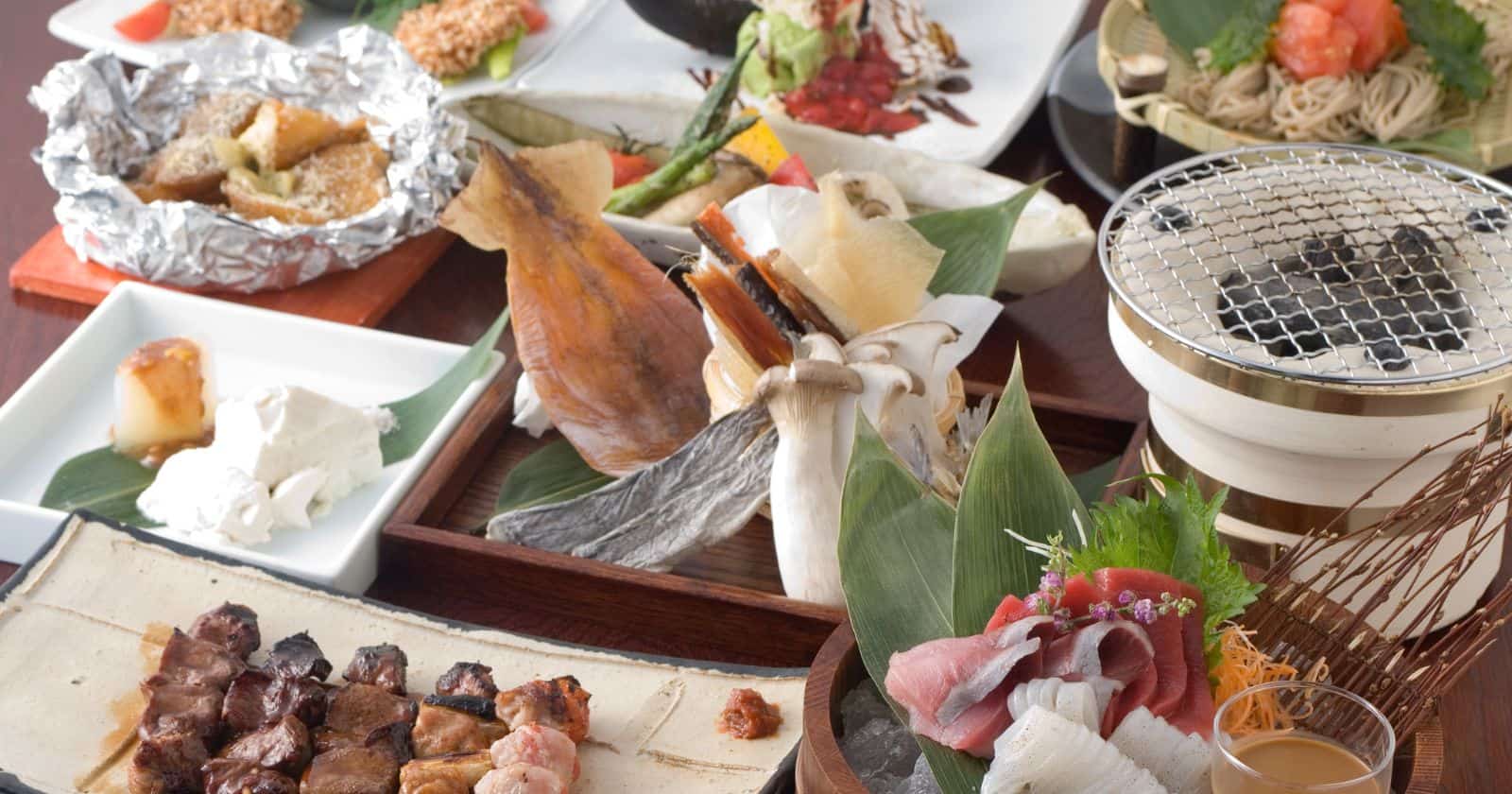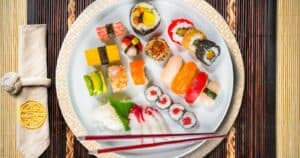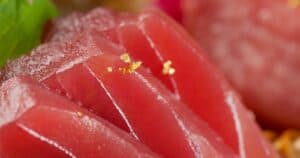Japanese food is known for its flavorful diversity, ranging from the savory richness of umami to the delicate sweetness of desserts. With ingredients like soy sauce, dashi, and mushrooms providing a meaty umami taste, Japanese cuisine truly stands out on the flavor spectrum.
Sweet flavors are commonly found in popular Japanese treats such as mochi and dorayaki, while saltiness elevates the natural essence of dishes through soy sauce, miso paste, and salt. Sour flavors can also be experienced through pickled vegetables and vinegared dishes, adding a refreshing tang.
Though not as prevalent, there are also hints of bitterness in certain Japanese ingredients like green tea and bitter melon.
Introduction to Japanese Cuisine: A Brief Overview
Japanese cuisine is a diverse and delicious representation of Japan’s unique culture and history. It has developed through centuries of political, economic, and social changes, and encompasses regional and traditional foods. Key features of Japanese cuisine include rice as a staple, a focus on seafood, a strong history of vegetarianism, the presence of umami, and regional dishes.
Rice is the foundation of traditional Japanese cuisine and is often served with miso soup and various dishes. Rice cakes, known as mochi, are also commonly consumed. Seafood plays a significant role in Japanese cuisine, with options ranging from grilled to raw in the form of sashimi and sushi. Seaweed, fish, clams, and fish cakes are also popular ingredients.
Due to Japan’s Buddhist heritage, vegetarianism has a strong history in the country. While fish is consumed, raw as sushi or sashimi, meat-based dishes like tonkatsu and yakiniku have become more common with modernization. Umami, a savory flavor, is a distinctive taste in Japanese cuisine and often found in fermented foods. Fermented soybeans, such as red miso, white miso, and soy sauce, are staple ingredients used in dressings, soups, and dipping sauces.
Regional dishes also play a role in Japanese cuisine, with some becoming familiar throughout the country. For example, Okinawan cuisine features taco rice, influenced by American and Mexican culinary traditions.
Balance and Umami: The Guiding Principles of Japanese Flavors
Umami, the fifth basic taste, is a fundamental principle of Japanese flavors. It refers to a savory and brothy quality that enhances the deliciousness of a dish. Derived from foods rich in glutamate and ribonucleotides, such as kombu seaweed and fermented soybean products, umami cannot be replicated by mixing other flavors.
In Japanese cuisine, umami is commonly found in broths, stews, and cooked meats, adding depth and richness to the overall taste. When used in balance with the other primary tastes of sweet, sour, salty, and bitter, umami elevates the flavor profile of Japanese dishes.
To fully understand the guiding principles of Japanese flavors, it is essential to delve into the concept of balance. Japanese cuisine places great importance on achieving harmony and equilibrium in every aspect of a meal. This idea of balance extends beyond taste to include texture, color, and presentation.
Each element is carefully considered to create a harmonious and satisfying dining experience. With umami as a guiding principle, Japanese chefs strive to achieve a delicate balance between the five primary tastes, ensuring that no flavor overpowers the others.
In Japanese cuisine, umami is not limited to specific ingredients but can be found in various dishes. The use of kombu seaweed, dried shiitake, dried katsuobushi fish, and fermented soybean products contributes to the umami flavor profile. These ingredients are often used to make dashi, a staple broth in Japanese cooking. The umami-rich dashi forms the foundation of many dishes, serving as a base for soups, sauces, and marinades.
By incorporating umami into different components of a meal, Japanese chefs achieve a harmonious balance of flavors that elevates the overall taste experience.
Traditional Flavors and Ingredients in Japanese Food
Japanese cuisine is known for its emphasis on the intrinsic flavor of ingredients, with seasonal and local ingredients preferred. The flavors and ingredients in Japanese food contribute to its distinct and delicious taste. Here are some traditional flavors and ingredients that form the core of Japanese culinary culture:
Rice:
Rice is a fundamental part of Japanese cuisine. It is the main staple, often served with miso soup and other dishes. In addition to plain rice, rice cakes (mochi) are also commonly consumed.
Soy sauce:
Soy sauce is an essential seasoning in Japanese cooking. Made from soybeans, wheat, salt, and water, it provides a salty and savory taste. It is used in dressings, soups, and dipping sauces to enhance the flavors of various dishes.
Miso:
Miso is another key seasoning in Japanese cuisine. It is made from fermented soybeans, rice, and barley. With its salty and savory taste, miso is primarily used to make miso soup and dressings. It adds depth and complexity to the dishes it is used in.
Mirin:
Mirin, a sweet rice wine, is widely used in Japanese cooking. It has a sweet and tangy taste and is often used in dressings, marinades, and sauces. Mirin helps balance the saltiness of soy sauce and miso, adding a unique flavor to the dishes.
Vinegar:
Vinegar, particularly rice vinegar, is commonly used in Japanese cuisine. Rice vinegar is used in sushi rice and dressings, providing a tangy and slightly sweet taste. It adds brightness to the flavors and helps to accentuate the other ingredients.
Katsuobushi:
Katsuobushi is dried, fermented, and smoked skipjack tuna. It is shaved into flakes and used to make dashi, a flavorful broth that forms the base of many Japanese dishes. Katsuobushi contributes a rich and smoky flavor to the broth, enhancing the overall taste of the dishes.
Kombu:
Kombu, a type of seaweed, is also used to make dashi. It has a savory and slightly sweet taste and is often added to soups and stews. Kombu brings umami flavor to the dishes, enhancing their depth and complexity.
Sake:
Sake, a Japanese rice wine, not only serves as a popular beverage but is also used as a seasoning in cooking. It has a mild and slightly sweet taste, making it an excellent ingredient to add depth to sauces and marinades.
These traditional flavors and ingredients highlight the unique and diverse taste of Japanese cuisine. The clean, fresh flavors and emphasis on umami contribute to the overall appeal and popularity of Japanese food.
Common Japanese Dishes: Exploring the Diversity of Tastes
Japanese cuisine offers a diverse and fascinating array of dishes that cater to various tastes. Here are some popular Japanese dishes that showcase the richness of flavors:
- Sushi: This famous dish consists of vinegared rice paired with an assortment of toppings, including raw fish, vegetables, and eggs. The combination of flavors and textures creates a unique culinary experience.
- Ramen: A beloved noodle soup dish, ramen features wheat noodles immersed in a savory broth made from meat or fish. It is commonly garnished with sliced pork, seaweed, and green onions, providing a satisfying umami taste.
- Tempura: A delightful side dish or appetizer, tempura is made by deep-frying seafood or vegetables in a light batter. The result is a crispy and flavorful dish that pairs well with a dipping sauce.
Japanese cuisine also offers other notable dishes like udon, a thick noodle soup with a rich broth; shabu-shabu, a hot pot dish with thinly sliced meat and vegetables; and curry rice, a hearty stew-like dish made with curry powder and an assortment of ingredients.
Regional Varieties and Unique Culinary Traditions
Japanese cuisine is incredibly diverse, with each region in Japan offering its own unique culinary traditions. From the fresh seafood of Hokkaido to the heartwarming stews of Tohoku, there is something for every food lover to enjoy. Here are some highlights of regional varieties and unique culinary traditions in Japan:
- Hokkaido: Known as a food lover’s paradise, Hokkaido is famous for its fresh seafood, dairy produce, meats, and vegetables. Some local specialties include Genghis Khan barbecue, where lamb and vegetables are cooked on a special grill, Ishikari hot pot, a delicious salmon and vegetable stew, and ruibe, a dish similar to salmon sashimi.
- Tohoku: The Tohoku region, located in the far north of Honshu island, has a culinary heritage closely tied to its cold winters. The region features heartwarming soups, hotpots, and stews as some of its specialties. One popular dish is called kiritanpo, which is a dish made of mashed rice formed into a stick shape and grilled.
- Tokyo and Osaka: In Tokyo, the focus is on sushi and sashimi, with fresh seafood being the highlight. On the other hand, Osaka is known for its savory pancakes called okonomiyaki, a delicious combination of batter, cabbage, and various toppings. Hokkaido is also famous for its ramen, a popular noodle dish loved by many.
Apart from these regional specialties, there are common ingredients and cooking styles that define Japanese cuisine. Key ingredients like rice, soy sauce, miso, seafood, sake, and wasabi are widely used in various dishes. Japanese cooking styles prioritize and enhance the natural flavors of ingredients. Grilling, boiling, and simmering are common preparation techniques used to bring out the best taste in food.
Fusion and Modern Influences in Japanese Cuisine
Fusion and modern influences have played a significant role in shaping Japanese cuisine. Over the years, various cultures have influenced Japanese culinary traditions, resulting in the creation of fusion dishes that combine Japanese and Western ingredients and cooking methods.
One prominent aspect of Japanese fusion cuisine is the incorporation of dishes commonly found in Western countries but given a Japanese twist. For example, steak, hamburger, and omelets are reimagined using Japanese ingredients, altering the flavors to suit Japanese taste palates. This blending of flavors creates a unique culinary experience that bridges the gap between different cultures.
The emergence of Japanese-Western fusion cuisine can be traced back to the early 20th century when Japan began incorporating ingredients and cooking methods from the West.
Culinary schools and women’s colleges started offering classes on Western cuisine, contributing to the adoption of Western influences in Japanese cooking. This period marked the beginning of a new era in Japanese cuisine, where traditional dishes were combined with Western elements to create innovative fusion dishes.
In the modern era, Japanese cuisine has further opened up to influences from various Western cuisines. Dishes like ramen, gyōza, spaghetti, curry, and hamburgers have been adapted to Japanese tastes and ingredients.
These variations reflect the cultural exchange and global influence of Japanese cuisine, which has inspired food cultures worldwide.
A prime example of modern Japanese fusion food is Wafu pasta, which combines Italian spaghetti with Japanese seasonings and ingredients. This blending of two distinct cuisines results in a unique flavor profile that appeals to both Japanese and Western palates.
The Art of Presentation: Aesthetic Appeal in Japanese Food
The art of presentation is crucial in Japanese cuisine, where minimalism, beauty, and uniqueness are key principles. Traditional Japanese dishes follow specific plating concepts and arrangements that emphasize aesthetics. Moritsuke, the Japanese art of presenting food, involves a highly codified process that considers cultural factors and accepted techniques.
Three elements govern the aesthetics of a traditional Japanese meal: the vessel, the food, and the space. The vessel refers to the plate or bowl on which the food is served. The food refers to the ingredients and how they are prepared, while the space refers to the empty spaces on the plate that create balance and harmony. Every detail matters, from the choice of plate to the arrangement of the food to create a visually stunning and pleasing dish.
Chefs pay attention to various visual aspects during food preparation, including the manner of tying or sewing meats and the type of cut used for chopping and slicing ingredients. Even the style of mold used in poured dishes adds to the artistry of Japanese cuisine presentation. The goal is to achieve a beautiful and harmonious balance between the vessel, the food, and the space, resulting in an aesthetically pleasing and visually appealing dish.
Seasonality and Freshness: Key Factors in Japanese Flavor
Seasonality and freshness are key factors in the unique flavor of Japanese cuisine. Traditional Japanese dishes, known as washoku, are prepared using fresh and locally sourced ingredients that are in season. The concept of seasonality, or shun, is highly valued in Japan, and it refers to the time of year when an ingredient is at its freshest and most flavorful.
In Japan, each season offers its own bounty of fruits, vegetables, and seafood, which are used to create delicious and vibrant dishes. Here are some notable seasonal foods for each season:
Spring: Cherry blossoms and strawberries are popular ingredients during this season. They add a touch of sweetness and freshness to dishes.
Summer: Cucumbers and tomatoes are abundant during the summer months. They are refreshing and perfect for cooling down in the hot weather.
Fall: Mushrooms and chestnuts are widely enjoyed in the autumn season. They add earthy flavors and textures to dishes.
Winter: Oysters and mandarin oranges are favored during the winter season. Oysters are known for their briny taste, while mandarin oranges provide a burst of citrus flavor.





